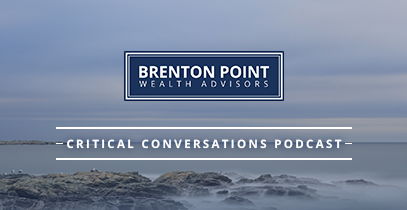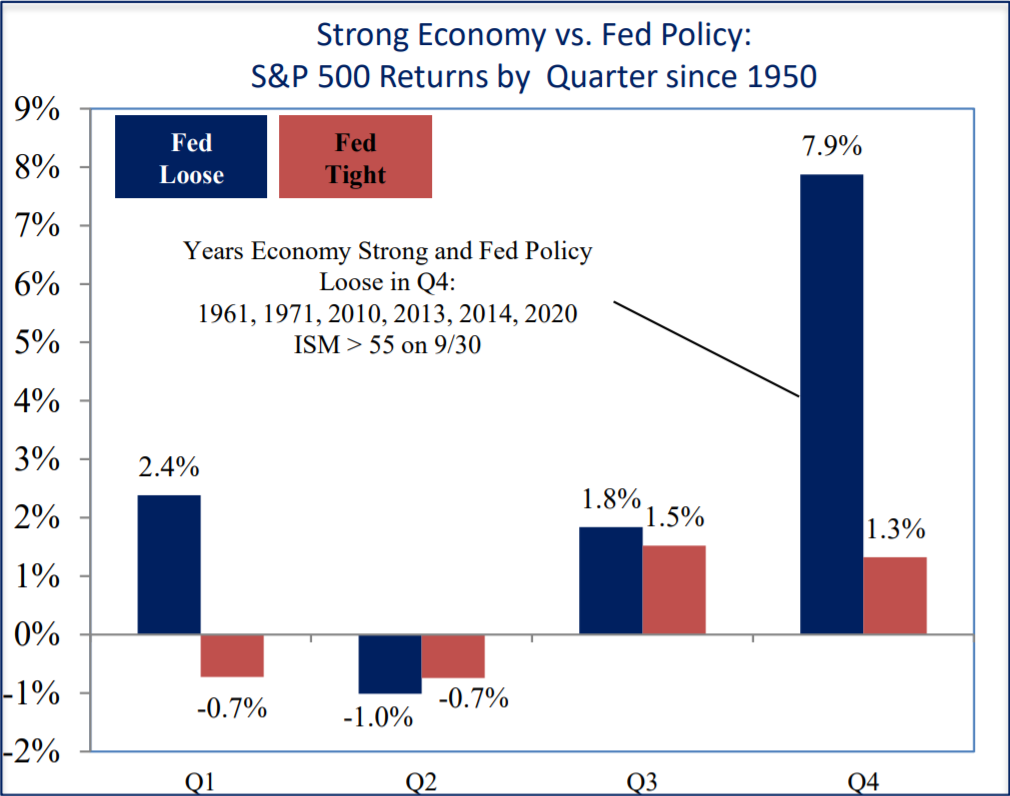Strong Stock Market: Bullish through March
Investing Environment Review and Outlook – Volume 54
Last month we discussed the historical bullish implications of a strong economy combined with a loose Fed in the fourth quarter. Since then, the October ISM Manufacturing index release above 60.0 demonstrated the economy remains strong. At the 11/3/21 FOMC meeting, the Fed announced the QE Taper as expected, and more importantly saw no imminent interest rate hike, thus remaining loose. Finally, the 7% S&P 500 October rally validated conditions were indeed positive for equities. This month we discuss prior cases when equities were this strong, the upside CPI inflation surprise, emerging markets’ outlook, and the surprising market expectations for Fed actions 4 years out.
We raised emerging markets to a bullish 5 rating. U.S. equities, foreign developed equities and gold remain a bullish 5 rating. Long-term bonds remain a cautious 2 rating and commodities remain a neutral 3.
Strong Stock Market: Bullish through March
The S&P 500 was up 7.0% in October and 24.0% YTD, in the 89th percentile of prior years since 1945. It would be logical to conclude it was overbought and due for a correction, but prior cases demonstrate the opposite. Only 8 prior years since 1945 were up more than 24% by October. And there were only 7 prior years that were up at least 5% in October and over 10% YTD. On average those years were up an additional 3.9% through December, very close to the positive norm for the last two months and nothing unusual. However, in the November to January period, the average return was 8.5%, almost twice the average for all other years. And in the November to March period, including the whole first quarter, the average return was 12.2%, also twice the average of 6.2% for all other years, and 29.2% annualized. The worst case and only down year was 1948, declining 6% from November to March. There are always downside risks, but in addition to a strong economy and loose Fed, we can now add strong equity market momentum to the bullish case.
Strong Equity Market Bullish through March
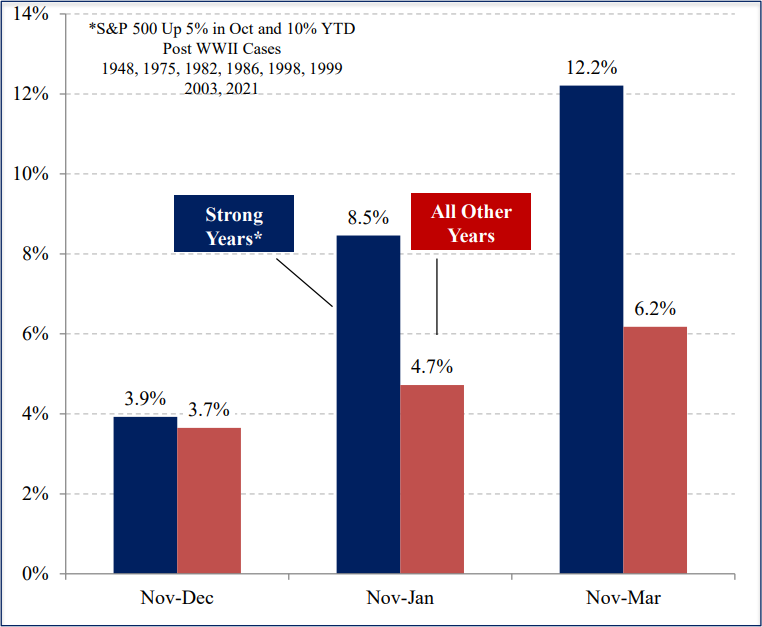
CPI Inflation Surprise: Bullish for Equities
The October CPI inflation was 6.2% Y/Y, the highest since 1990 at the stock market low after oil doubled to $40 during Kuwait invasion (Gulf War I). Prior to that it was the highest since 1982. There was a base effect this month since CPI increased just 0.1% M/M a year ago. The bad news is high comps (making it easier for Y/Y to decline) don’t start until March. The prior 4 cases of inflation this high didn’t turn lower until we saw a recession (1990, 1980, 1974, 1970). However, in 1950 the Korean War inflation spike to 9% reversed quickly back to 2% without a recession, which is a possible scenario. Historically high inflation was bullish for equities while the Fed was loose as they are today. In fact, with higher inflation and no change from the Fed in October, the Fed effectively eased monetary conditions. Our inflation outlook indicators remain elevated at 86.1 and indicators like ISM deliveries index show that supply bottlenecks continue putting upward pressure on prices. In theory bottlenecks will clear and prices will come down quickly, particularly if companies have ordered more than they actually need.
CPI Inflation Over 6% Highest Since 1990/1982 Inflation Outlook Remains Elevated
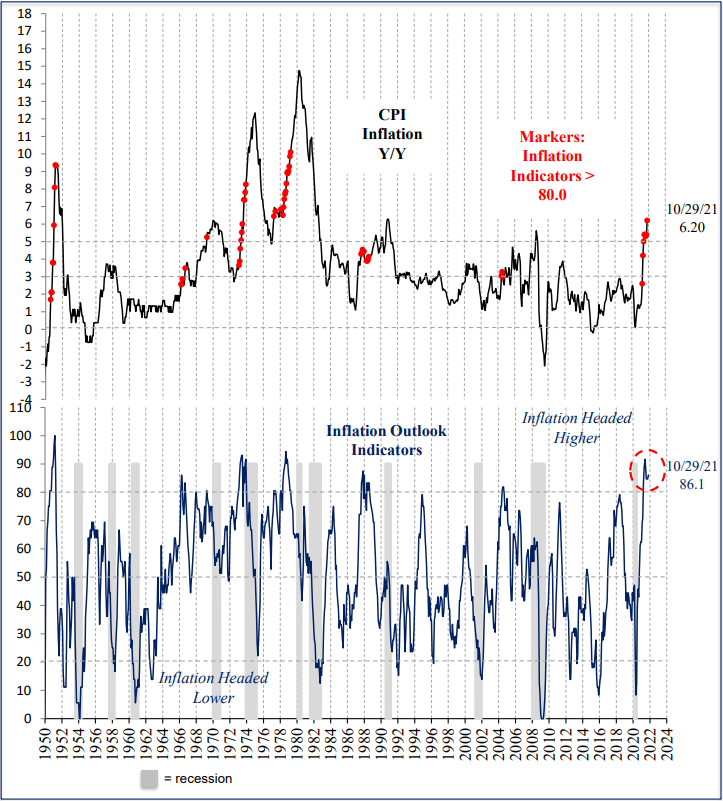
ISM Deliveries Index Up: Bottlenecks Remain
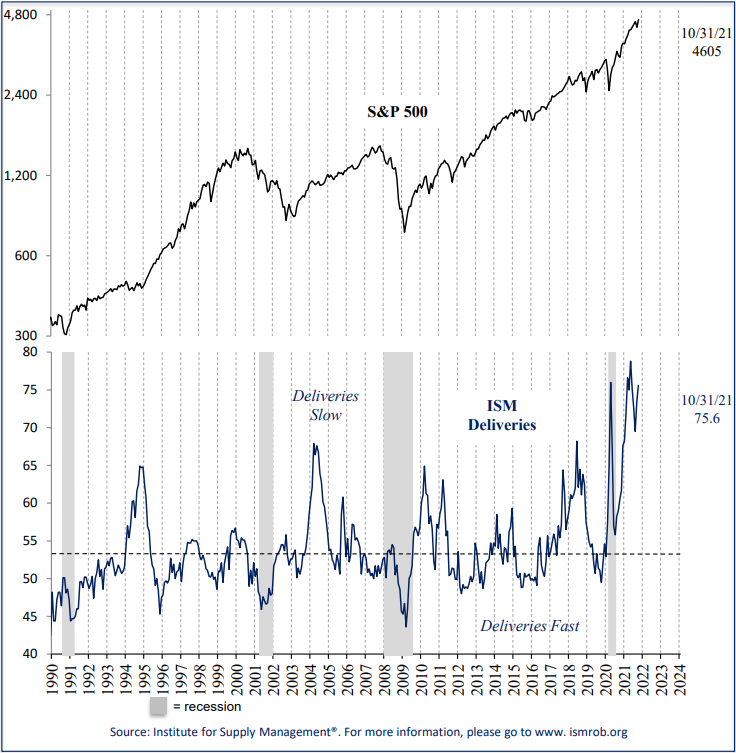
Emerging Markets Ratings Uptick
We increased the emerging markets rating to a bullish 5, based on various bullish leading indicators like strong industrial commodities, extreme investor positioning, seasonality and strong gold stocks. The combination was followed by strong emerging market returns historically, despite the strong dollar offset. The MSCI Emerging Markets Index is down 2% this year, vastly underperforming the S&P 500 by over 20%. This reflects the extreme investor positioning into U.S. stocks and the dollar strength. At some point we expect this will reverse as investors shift out of the U.S. into the undervalued emerging markets, leading to a reversion in performance.
S&P 500 vs. MSCI Emerging Markets Index
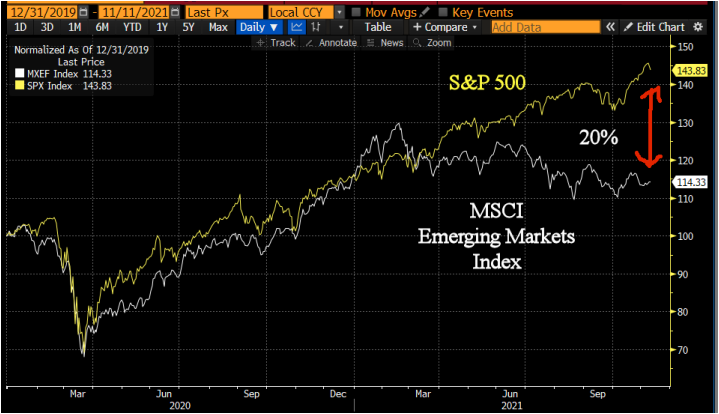
Institutions Out Of Emerging Markets
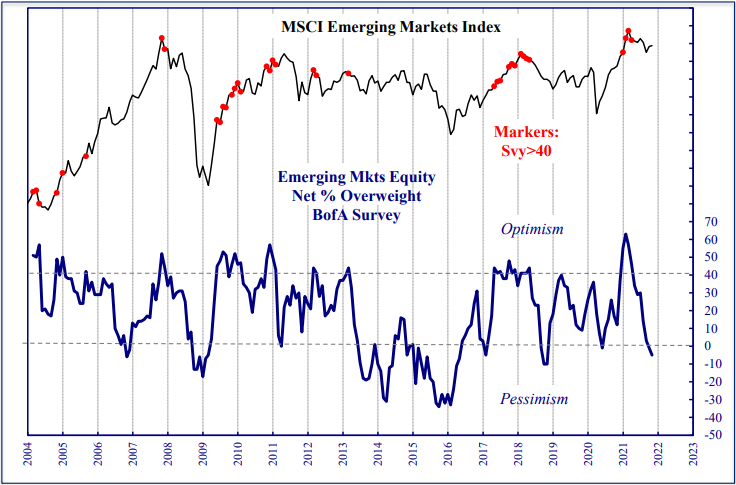
Bond Investors: Inflation will Return to 2%
The bond futures market expects a peak Fed Funds rate of just 1.8% over the next 4 years. That is highly unusual considering inflation today at 6.2%, and even the Fed’s own long run projection of the Fed Funds rate is higher at 2-3%. What is more incredible is that in all 15 hiking cycles since 1950, the Fed hiked rates above the inflation rate. For instance, in the last cycle starting in 2015, the Fed hiked the Fed Funds rate from 0% to 2.5% by the last move in December 2018, hiking above the inflation rate of 2.2% as they always did. It was the same pattern for every cycle back to 1950. It appears that bond investors believe inflation will indeed be transitory and return to 2%, or if not, the Fed will not hike like they did in prior cycles. We will be watching leading inflation indicators and bond market expectations for clues on the Fed’s future actions. In the meantime, the Fed remains loose by any measure.
Bond Market Expectations For Fed Funds Peak Under 2.0% 4 Years Out
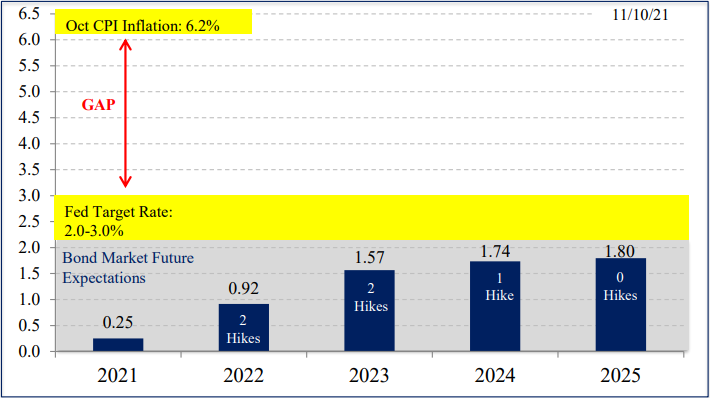
The Fed Hiked Above The Inflation Rate In Every Business Cycle Since 1950
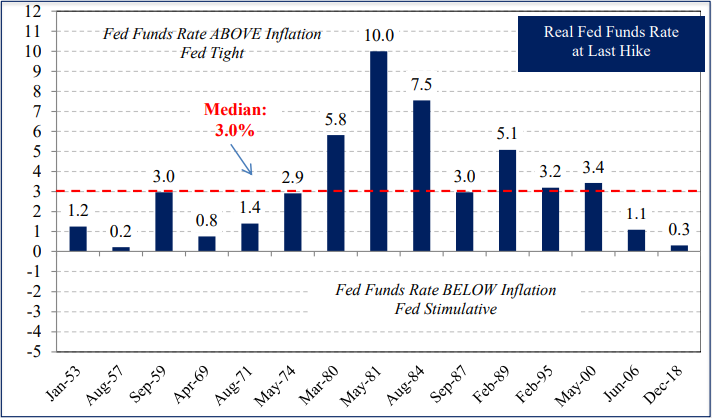
Summary
Equity indicators improved further in November, with a particularly strong outlook through the first quarter in prior years with similar conditions. Emerging markets are seemingly poised for upside now that institutions have cut back. U.S. inflation was a big upside surprise in October as the headlines showed, and our inflation outlook indicators remain elevated. Investors are nervous about the Fed reaction, but until then it equates to a Fed easing. The biggest risks for equities appear to be extreme investor positioning and eventually the inevitable tight monetary policy. We will continue testing conditions as they change. Thank you for your support and please contact your advisor with any questions.
IMPORTANT DISCLOSURES
This review and outlook report (this “Report”) is for informational, illustration and discussion purposes only and is not intended to be, nor should it be construed as, financial, legal, tax or investment advice, of Brenton Point Wealth Advisors LLC or any of its affiliates (“Brenton Point”). This Report does not take into account the investment objectives, financial situation, restrictions, particular needs or financial, legal or tax situation of any particular person and should not be viewed as addressing any recipient’s particular investment needs. Recipients should consider the information contained in this Report as only a single factor in making an investment decision and should not rely solely on investment recommendations contained herein, if any, as a substitution for the exercise of independent judgment of the merits and risks of investments.
This material is based upon information obtained from various sources that Brenton Point believes to be reliable, but Brenton Point makes no representation or warranty with respect to the accuracy or completeness of such information. Views expressed herein are current only as of the date indicated and are subject to change without notice.
This Report contains certain forward looking statements opinions, estimates, projections, assessments and other views (collectively “Statements”). These Statements are subject to a number of assumptions, risks and uncertainties which may cause actual results, performance or achievements to be materially different from future results, performance or achievements expressed or implied by these forward looking statements and projections. Brenton Point makes no representations as to the reasonableness of such assumptions or the likelihood that such assumptions will coincide with actual events and this information should not be relied upon for that purpose. Changes in such assumptions could produce materially different results. Past performance is not a guarantee or indication of future results, and no representation or warranty, express or implied, is made regarding future performance of any financial instrument mentioned in this Report.
Any benchmark shown herein is shown for illustrative purposes only. No index benchmark is available for direct investment. It may not be possible to replicate the returns of any index, as the index may not include any trading commissions and costs or fees, may assume the reinvestment of income, and may have investment objectives, use trading strategies, or have other materials characteristics, such as credit exposure or volatility, that do not make it suitable for a particular person. This is not an offer or solicitation for the purchase or sale of any security, investment, or other product and should not be construed as such. References to specific financial instruments and to certain indices are for illustrative purposes only and provided for the purpose of making general market data available as a point of reference only; they are not intended to be, and should not be interpreted as recommendations to purchase or sell such securities. Investing in securities and other financial products entails certain risks, including the possible loss of the entire principal amount invested, as the value of investment can go down as well as up. You should obtain advice from your tax, financial, legal, and other advisors and only make investment decisions on the basis of your own objectives, experience, and resources.
Brenton Point accepts no liability for any loss (whether direct, indirect or consequential) occasioned to any person acting or refraining from action as a result of any material contained in or derived from this Report, except to the extent (but only to the extent) that such liability may not be waived, modified or limited under applicable law.
This Report may provide addresses of, or contain hyperlinks to, Internet websites. Brenton Point has not reviewed the linked Internet website of any third party and takes no responsibility for the contents thereof. Each such address or hyperlink is provided solely for your convenience and information, and the content of linked third party websites is not in any way incorporated herein. Recipients who choose to access such third-party websites or follow such hyperlinks do so at their own risk.
All marks referenced herein are the property of their respective owners. This Report is licensed for non-commercial use only, and may not be reproduced, distributed, forwarded, posted, published, transmitted, uploaded or otherwise made available to others for commercial purposes, including to individuals within an institution, without written authorization from Brenton Point.
Source of data and performance statistics: Bloomberg L.P. and Factset Research Systems Inc.
©Brenton Point Wealth Advisors LLC 2021

Michael Schaus
Director of Market Research
Michael Schaus is the Director of Market Research for Brenton Point Wealth Advisors and Zweig-DiMenna. Since joining Zweig-DiMenna in 1992, his focus has been on macroeconomic research, the analysis of…
READ MORERead Next:
Sign up!
Sign up for our monthly newsletter and get the lastest news and research from our esteemed advisors here at Brenton point. Right into your inbox!


 Client Login
Client Login

